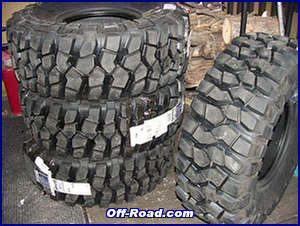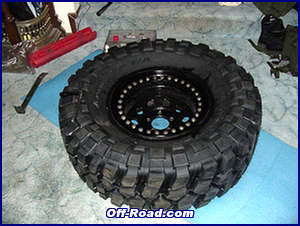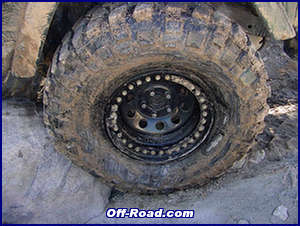|
BFG Krawler T/A
|
 |
|
This was the pleasant surprise that arrived at my
doorstep. A set of blue sticker BFG Krawler K/Xs. Without
air in them they measured 34.75 inches tall and weighed in at 80
lbs each.
|
I'd like to note that for a 35 inch tall tire, the Krawlers actually measure 34.75 inches tall without air in them at all! Yes folks, we have a tire that is pretty dang close to what it claims says to be, which is rather rare as most off road/ rockcrawling tires can be much shorter than the advertised height.
However, we must pay the price of having that much more tire apparently, as these guys aren't light. The Krawlers weigh in at 80 pounds per tire, according to the UPS tag that was slapped on them. But you probably don't plan to be speeding around if you were even considering a set of Krawlers, so do you care if they're heavy?
Our Krawlers were of the "blue sticker" compound, which is a slightly stiffer and longer-lasting tread compound than the super soft "red sticker" competition compounds, which have won such acclaim in the rockcrawling world.
Anyone familiar with mounting bead locks knows just how much of a time-consuming process it is. After I was done mounting these tires to the 32 bolt Allied wheels, I personally wanted to have a long lasting tread compound and was more than happy to give up a little compound softness so I wouldn't have to be mount up another set any time soon. I had them balanced at a local tire store and had the Krawlers filled to 30 PSI.
After the first drive on the Krawlers, my initial observations were that these tires were reasonably easy to balance, and had decent road manners for being so heavy and aggressive. While noticable, road noise is actually less than I expected. I can say that I've had tires that weren't anywhere near as aggressive that were much louder on the road. You can definitely feel the aggressive lugs in corners through the steering wheel as you make tight turns.
But perhaps the most-noted observation after you first mount up a set of Krawlers on to your rig is that they closely resemble the tread pattern found on tractors and those huge military transport trucks. The Krawler looks like a down-sized but slightly more-aggressive spin off of that design.
I drove around on the Krawlers for almost two long weeks before I got a chance to try them on their home turf on the trails. After two weeks of driving through icy roads, deep snow and rainy roads however, I can say that the Krawlers handled themselves very well for a tire that was so heavy, and didn't have any siping in the blocks. In deep snow they required very little wheel spin to clean the tread face and move the Jeep. On more than one occasion it would rain after dropping down several inches of snow, leaving behind a particularly slick and thick slush that ordinary tires where having a very difficult time getting around in. The Krawlers excelled here by just evacuating the thick slush out of the way, leaving a completely cleared wide path behind them. They had literally picked up all the slush and thrown it off. I can't say as I've seen a tire do that before. Ever. This hints to me right away that these tires are going particularly shine in your local mud pit.Icy roads are usually difficult for many of the larger block tread designs, but I found the Krawlers to still get around. Nothing too spectacular, but I can honestly say I didn't need tire chains - just slow, cautious driving to get around. I think the extra width that the 13.50" wide foot print really does helps out here by making more rubber available to icy road surfaces.
Then it was finally time to test the Krawlers on the trails. I went up to Big Bear California to the "John Bull" trail, to conduct what would an interesting test of the Krawlers. The John Bull is a reasonably-tough trail even under good conditions, that now had two feet of snow on it in areas. The snow had made the nice clay road to the trailhead a two-mile-long mud pit. This was the perfect time to see how the Krawlers would fair in some pretty sticky mud.I gunned it and plowed into the mud. The first thing I noticed was how good the Krawlers were at self-cleaning. They were throwing mud all over the place with very little wheel spin. I was able to stop in the middle of several two-foot deep mud pits and pull out with no problem. They did much better than I had expected in the mud, for a rockcrawling-designed type of tire. The Krawler is most definitely capable of competing with the proven mud tires currently produced.
The only thing you have to watch for is that these tires love to dig. Even with their 13.50 wide tread face, they will dig to find the firm base and pull you through. You'd need a tall rig if you were going to go through deep mud pits with a set of Krawlers. The tires won't load up, but they may dig until you get stuck.
 |
|
These tires love to conform to rocks. Here the
sidewall is actually pinched.
|
I found the Krawlers would grip equally well to either dry and wet rock. With the Krawlers aired down to 9 PSI, I was able to point the Jeep at any line in the wet slushy rock sections and slowly idle the Jeep through without any side-to-side slipping. The Krawlers conformed to the rocks very well, and the side lugs really helped grip and turn on rocks. I never had the, "I shouldn't turn or I'll slip off the rock I'm on" feeling that I've had with other tires on wet rock sections. I felt confident with the side bite these tires displayed. In the dry rock I thought I might be able scuff up the sidewalls, or perhaps even puncture them on some roots or sharp rocks. However, I had these tires pinched, poked, and stabbed by everything I could roll them onto, and I never once was able to even scuff the tires. Their durability was impressive.
 |
|
These Krawlers allow you to set your rig on wet
rocks without worry of slipping off.
|
If you're in the market for an extreme performance tire for your rock rig, you should consider the Krawler. The price tag is high, but you'll find that these tires earn their way on the rocks, in the mud, snow, ice and even on the road. They get the highest score for durability, and you just can't beat the drool factor.
Think of these kind
of like "bling" for rockcrawlers!
|
www.JeepWeb.com |






